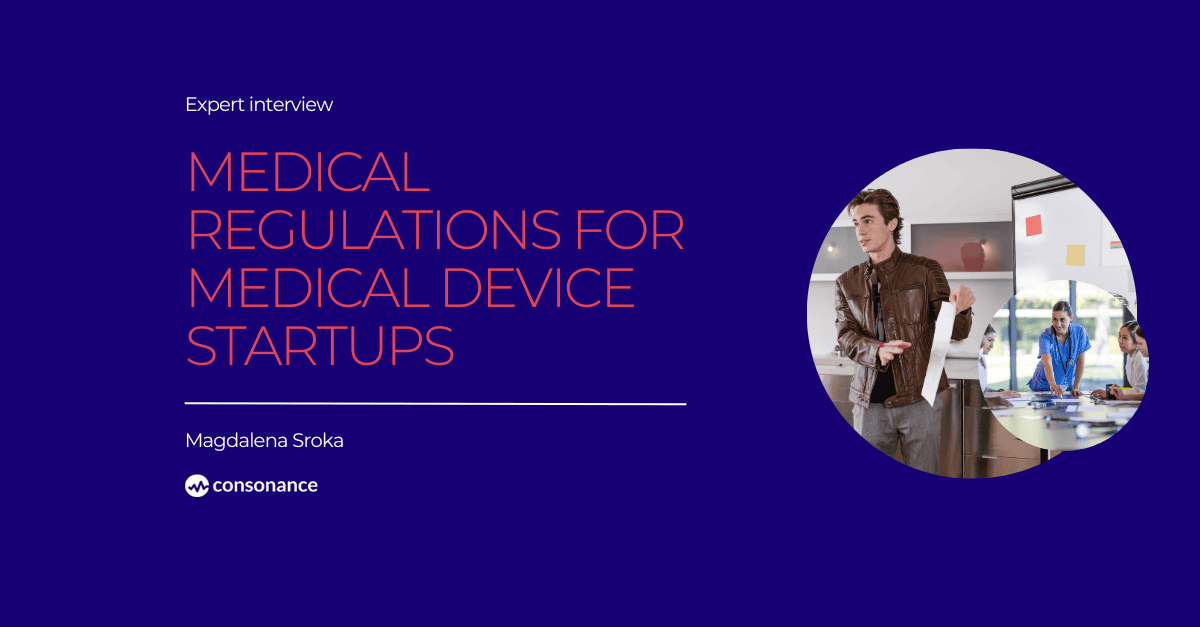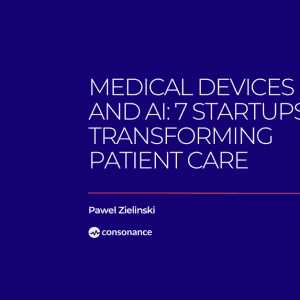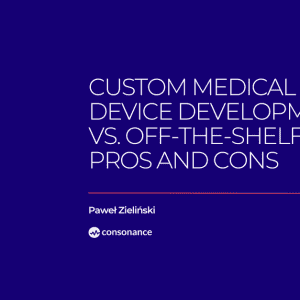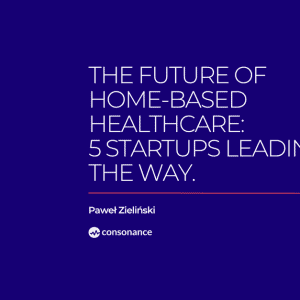Medical Regulations for Medical Device Startups – expert interview

It is often said that medical regulations are for a reason. There is no room for mistakes in the medical industry. What if a minor error could have dire consequences, and in extreme cases, it can cost human lives? Therefore, every medical device startup before releasing a product to the market, must face a series of requirements.
For most people (especially when you build your product for the first time), understanding the complexities of medical regulations or keeping up with changes feel like navigating an endless maze. Non-compliance with regulations means that startups’ medical devices will not be allowed on the market, and they may also face fines. Fortunately, there are individuals who know how to navigate this maze and are capable of guiding companies through the complex regulatory processes.
While working on various projects in recent years, we have noticed that clients come with very similar questions regarding medical regulations. The person addressing these questions at Consonance is Sabina Matysiak, Quality Manager, R&D Engineer and she will answer a few of them below.
Hi Sabina, thank you for sharing your time and know-how. Let’s delve deeper into medical regulations
The classification of the device and the registration process itself can vary significantly in complexity and duration, affecting the time to market. Some of our clients are targeting i.e. developing markets in Africa, South America or even Asia. So it means familiarizing with local laws and requirements is simply necessary to pass “the exam”. On the other hand – if you plan anything familiar – check if a particular country respects FDA or MDR or PMDA which would be quite handy. You could certify a medical device on many markets simultaneously. Yet, which one to choose depends on a commercialization strategy.
For most people (especially when you build your product for the first time), understanding the complexities of medical regulations or keeping up with changes feel like navigating an endless maze. Non-compliance with regulations means that startups’ medical devices will not be allowed on the market, and they may also face fines. Fortunately, there are individuals who know how to navigate this maze and are capable of guiding companies through the complex regulatory processes.
While working on various projects in recent years, we have noticed that clients come with very similar questions regarding medical regulations. The person addressing these questions at Consonance is Sabina Matysiak, Quality Manager, R&D Engineer and she will answer a few of them below.
Hi Sabina, thank you for sharing your time and know-how. Let’s delve deeper into medical regulations
Name two questions you most frequently receive regarding medical regulations?
Hi Magda. That’s a good one! Well, I think two most common are:- Do you need to have ISO 13485 implemented at the time of certification, and so subcontractors also need to have this standard implemented?
- What documents need to be prepared for the certification process?
Why do you think the certification process is so difficult?
In my opinion, it stems from the fact that many medical device startups consider certification as an afterthought, a subsequent step following production. In reality, they should be thinking about certification from the very beginning of the design and development process. It is much harder to adjust a finished product to meet regulatory requirements than to design it according to those requirements from the start. As an example: we faced a problem when a startup company built a rather expensive and advanced MedTech product. After conducting a technical audit and documentation review, we found they missed a few important details regarding technical requirements and certification. As a result, they burnt $1 M and still they had no product ready for approval. That’s why you need to think about certification from the very beginning.What are the most common mistakes new startups make when interpreting regulatory requirements?
For new startups, problems can arise right from the start during the risk classification of the product according to applicable classification rules. Incorrect classification of the device leads to the wrong regulatory pathway. Different classes have different requirements, and errors can cause significant delays. Failure to recognize and comply with additional local regulatory requirements that may apply in some countries or regions. Implementing only parts of the relevant standards and guidelines, resulting in non-compliance.How can the certification process be effectively managed to minimize delays?
Early planning, understanding the CE / FDA / PMDA certification requirements, and developing a detailed project plan with clearly defined milestones and responsibilities. Work on reliable documentation, both system and technical, as well as thorough risk assessment. Well-documented clinical evaluation to demonstrate safety and performance is a must-have. Any R&D project requires validation after most critical development phases. Conducting necessary product tests in accredited laboratories and ensuring reports are complete and included in the technical documentation.What are the most common issues related to maintaining ISO 13485 compliance?
Based on my experience, I could point out two basic patterns: managing documentation, which is usually very extensive, is certainly demanding and ensuring that the documentation is consistent, up-to-date, and reflects processes and procedures can be challenging and is crucial for compliance with the standard’s requirements.In your opinion, what would be the best advice for medical device startups planning to create a medical product?
To take advantage of our services 😉 and to thoroughly understand and familiarize themselves with the regulatory requirements applicable depending on the target market, such as MDR in Europe, FDA requirements in the USA, and other local regulations which vary in different locations.What are the main challenges related to adapting a medical device to the regulatory requirements of different international markets?
Each country or region has its own set of regulations, standards, and approval processes (e.g. FDA in the USA, MDR in the EU, PMDA in Japan). Consequently, each regulatory body may require different types and formats of documentation, including technical documentation, clinical data, and quality management system records. Submissions and accompanying documents often need to be translated into the local language, which requires precise and accurate translation to avoid misunderstanding and ensure regulatory compliance.The classification of the device and the registration process itself can vary significantly in complexity and duration, affecting the time to market. Some of our clients are targeting i.e. developing markets in Africa, South America or even Asia. So it means familiarizing with local laws and requirements is simply necessary to pass “the exam”. On the other hand – if you plan anything familiar – check if a particular country respects FDA or MDR or PMDA which would be quite handy. You could certify a medical device on many markets simultaneously. Yet, which one to choose depends on a commercialization strategy.






